Tech News
-
Zyphra Demonstrates First Large Scale Training on Integrated AMD Compute and Networking Powered by IBM Cloud
Joint collaboration between Zyphra, AMD, and IBM delivers ZAYA1, the first large-scale Mixture-of-Experts foundation model trained entirely on an AMD platform using AMD Instinct MI300X GPUs, AMD Pollara networking & ROCm software.
SAN FRANCISCO, Nov. 24, 2025 /PRNewswire/ -- Zyphra today announced a major milestone in its AI infrastructure and model development with the release of a technical report showing how Zyphra has demonstrated large scale training on AMD GPUs and networking.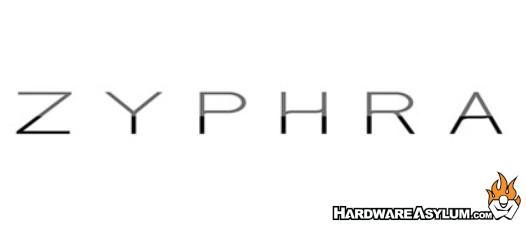
The paper introduces ZAYA1, the first large-scale Mixture-of-Experts (MoE) foundation model trained entirely on an integrated AMD platform (AMD Instinct™ GPUs, AMD Pensando™ networking interconnect & ROCm software stack) as a viable high-performance, production-ready alternative platform for frontier-scale AI training.
Despite operating at a fraction of the active parameter count, ZAYA1-base (8.3B total parameters, 760m active) achieves performance comparable to leading models such as Qwen3-4B (Alibaba) and Gemma3-12B (Google), and outperforms models including Llama-3-8B (Meta) and OLMoE across reasoning, mathematics, and coding benchmarks.
"Efficiency has always been a core guiding principle at Zyphra. It shapes how we design model architectures, develop algorithms for training and inference, and choose the hardware with the best price-performance to deliver frontier intelligence to our customers," said Krithik Puthalath, CEO of Zyphra. "ZAYA1 reflects this philosophy and we are thrilled to be the first company to demonstrate large-scale training on an AMD platform. Our results highlight the power of co-designing model architectures with silicon and systems, and we're excited to deepen our collaboration with AMD and IBM as we build the next generation of advanced multimodal foundation models."
Mixture-of-Experts (MoE) models have become the foundational architecture for modern, frontier AI systems, using specialized expert networks that activate dynamically to deliver greater efficiency, scalability, and reasoning performance than traditional dense architectures. This paradigm shift defines today's leading frontier models including GPT-5, Claude-4.5 DeepSeek-V3 and Kimi2 all of which leverage MoE designs to expand capability while optimizing compute utilization. ZAYA1 represents the first large-scale pretraining of an MoE model on an AMD platform, demonstrating that the AMD AI ecosystem is ready to power frontier-class AI development end-to-end.
Zyphra co-designed ZAYA1 around AMD silicon, introducing innovations such as an advanced routing architecture, Compressed Convolutional Attention (CCA), and lightweight residual scaling to achieve higher training throughput and more efficient inference through improved expert utilization.
"Zyphra's work with AMD and IBM demonstrates how an open platform built on AMD Instinct GPUs and AMD Pensando networking can deliver breakthrough performance and efficiency for large-scale AI," said Philip Guido, EVP and Chief Commercial Officer, AMD. "This milestone underscores how innovative AMD hardware and software solutions are enabling the next wave of frontier AI development with industry leaders."
Building on prior collaborative work and to achieve this milestone, Zyphra collaborated closely with AMD and IBM to design and deploy a large-scale training cluster powered by AMD Instinct GPUs with AMD Pensando networking (ethernet) interconnect. The jointly engineered AMD and IBM cluster announced earlier this quarter, combines AMD Instinct MI300X GPUs with IBM Cloud's high-performance fabric and storage architecture providing the foundation for ZAYA1's large-scale pretraining.
"As AI creates opportunities for enterprises to innovate, foundation models are key to unlocking accelerated development, efficiency and productivity," said Alan Peacock, GM of IBM Cloud. "We are proud to deliver IBM's scalable AI infrastructure as the foundation for ZAYA1's large-scale model and are excited to continue collaborating with AMD on AI model development across our mutual clients."
The joint collaboration demonstrates how Zyphra's advanced AI research and optimized software stack, combined with the AMD platform powered by IBM's infrastructure through IBM Cloud can deliver the performance needed for reliable frontier-scale AI model development.
-
Thermaltake View 390 Air Mid Tower Chassis and 6.0'' LCD Screen Review @ Funky Kit
Funky Kit positions the Thermaltake View 390 Air as a mid tower chassis that actually feels like it was designed by a real system builder, with airflow and usability as the main focus. It uses a 4 mm curved tempered glass side panel for a distinctive showcase look, paired with a full mesh front and three pre installed 140 mm fans that move a lot of air, so most users will not need to swap fans immediately or worry about thermal throttling. Inside, there is generous space for large GPUs and even E ATX boards, support for vertical GPU mounting, a built in GPU support bracket, and neat cable management with multiple routing channels and Velcro straps. The tool free tempered glass side panel that swings open like a door is highlighted as a very practical touch for quick upgrades and tweaks.
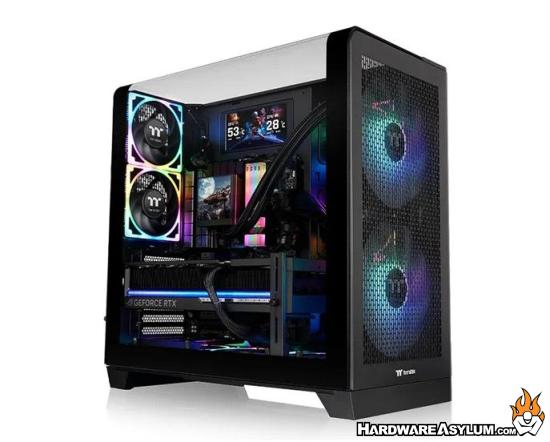
" ... Looking to upgrade your case? The Thermaltake View 390 Air and its optional 6.0'' LCD Screen Kit combine smart design with real personality, giving builders a case that’s both functional and fun to work with. If you want a PC setup that runs cool, looks sharp, and feels uniquely yours, this combo delivers. "
The optional 6.0 inch LCD screen integrates cleanly into the chassis and can show system stats or custom images, giving the build a more premium, custom look, although it is an extra purchase on top of the case itself. Overall scoring is very strong, with 9 for features, 9 for build quality, 10 for aesthetics, 9 for compatibility and 8 for installation, averaging out to 9.0 out of 10, and the reviewer explicitly notes no meaningful drawbacks. With street prices around 150 to 165 US dollars for the case and roughly 100 US dollars for the LCD kit, Funky Kit sees the View 390 Air as an excellent balance of strong airflow, clean modern aesthetics and builder friendly details that make it a very easy case to recommend. -
MSI MPG CORELIQUID P13 Liquid CPU Cooler Review @ ThinkComputers
ThinkComputers sees the MSI MPG CORELIQUID P13 as a very slick-looking 360 mm AIO, especially in the white version, with three 120 mm CycloBlade 9 ARGB fans, a 27.2 mm-thick 360 mm radiator (20 FPI), and a standout 2.1″ 480×480 circular LCD on the pump. Installation is described as straightforward thanks to universal AMD/Intel mounting hardware, pre-installed fans in push, very flexible EPDM tubing, a magnetic pump cover that hides the mounting hardware, and MSI’s “Streamline” cable routing and fan daisy-chaining that keeps the build visually clean. There is also a JAF combo header option for power/RGB if the motherboard supports it, although MSI has moved to a QR-code digital-only manual.
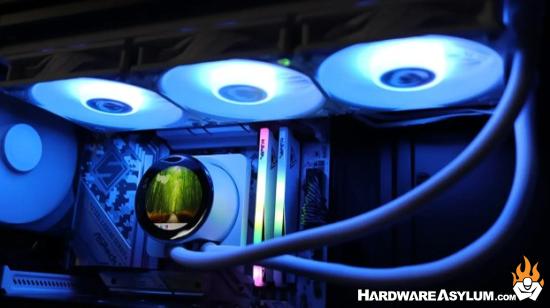
"When you hear the name MSI, you probably first think about motherboards and graphics cards, maybe laptops and monitors, but you may not heavily relate the MSI brand to CPU coolers. If that is the case for you, then let's just get it out of the way – MSI does offer CPU coolers, and in fact, you can build a PC with all MSI products, other than the CPU and RAM. And in this review we are taking a look at one of MSI's latest coolers, the MPG CORELIQUID P13, a 360mm all-in-one liquid cooler. The P13 is loaded up with ARGB fans, an LCD-equipped pump housing, and more, so let's jump right into this review!"
On the test bench with a Ryzen 7 7600X, the P13 ends up on the warm side of the comparison charts at both idle and load, even at higher fan speeds. The reviewer attributes this to the compromise CycloBlade fan design, which tries to balance airflow and static pressure, resulting in a cooler that is pleasantly quiet but not especially strong at pushing air through the dense radiator. The LCD is flexible in theory, with hardware monitoring, video, system clock, and extended display modes, but MSI Center is called out as a real weak point: no simple way to push custom images, limited sensor support, very similar LCD themes, and an annoying requirement to fully launch the app before the screen even turns on. Overall the verdict is mixed: great aesthetics, a neat LCD and cable management, but lackluster thermals and clunky software for around $189.99, earning a 7/10 and recommended mainly for MSI-focused builds where matching looks and quiet operation matter more than raw cooling performance. -
Best Starter 3D Printers on Amazon
Entry-level 3D printing has grown up. In the sub-$400 range, you can now get auto bed leveling, faster motion systems, quieter electronics, PEI build plates, and slicer profiles that produce clean first layers without spending a weekend chasing offsets. That means beginners can unbox, load PLA, and hit Print in a manner of minutes with a much higher success rate, while hobbyists can push speeds and materials without rebuilding the entire machine.
For this guide, we focused on four budget FDM models that are currently available on Amazon US, each from a different brand. The selection criteria are simple and practical: dependable auto leveling, a rigid motion system that stays square, sensible default profiles, straightforward maintenance, with build surfaces that releases parts without drama.
The same maintenance rules apply, If you pair any of these printers with quality PLA or PETG, keep the plate clean, and resist the urge to max out speeds on day one and you will go from idea to finished part quickly and consistently.
Hardware Asylum’s 4 best budget picks1. Flashforge Adventurer 5M Pro
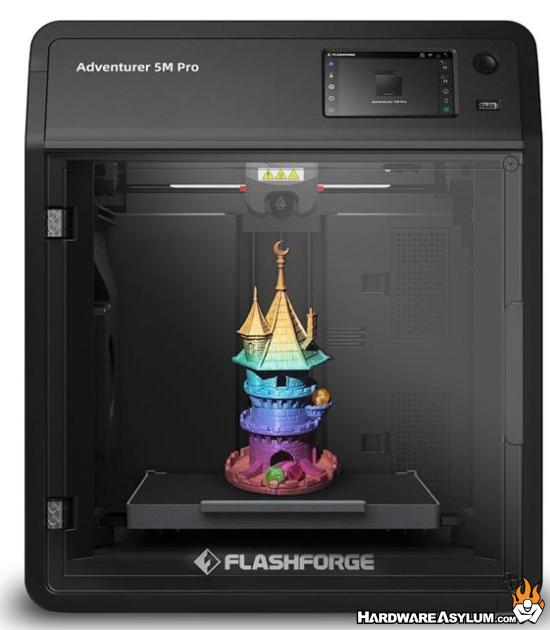
Brief introduction: An enclosed, desk-friendly CoreXY that is unusually quiet and tidy for apartments and shared spaces. One-click auto leveling and quick-swap nozzles make it beginner-friendly without killing growth potential.
Key specs:- Kinematics: CoreXY chassis for stable high-speed moves
- Auto leveling: One-click, fully automatic routine
- Hotend: Quick-release nozzle up to high temps for common filaments
- Build plate: Dual-sided PEI flexible sheet
- Use case: Functional prints, small cosplay parts, living room setups
Why this pick: If you want the least tinkering and a clean footprint, the AD5M Pro is the easiest machine here to live with day to day. The enclosure helps with noise and airflow, and the guided setup shortens the time to a successful first print.
2. Creality Ender-3 V3 SE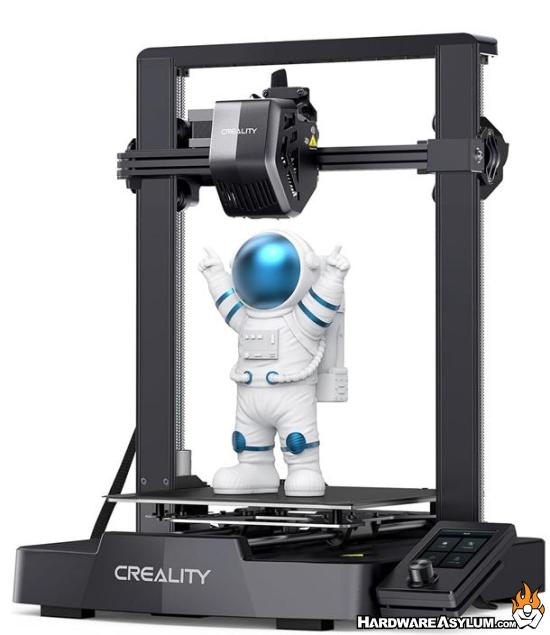
Brief introduction: The modernized Ender that fixes first-layer roulette. CR-Touch leveling, strain-based Z offset, a PEI-style plate, and up to 250 mm/s rated speed make this a friendly first printer or a reliable second machine.
Key specs:- Leveling: CR-Touch probe with assisted Z offset
- Extruder path: Sprite-style direct path for better retraction and flex printing
- Build volume: 220 × 220 × 250 mm class
- Plate: Spring-steel PEI style for easy part release
Why this pick: If you want the most community guides and spare parts with a very low barrier to entry, the V3 SE is a safe default. It nails first layers and everyday PLA or PETG without heavy tuning.
3. Anycubic Kobra 3 V2 Combo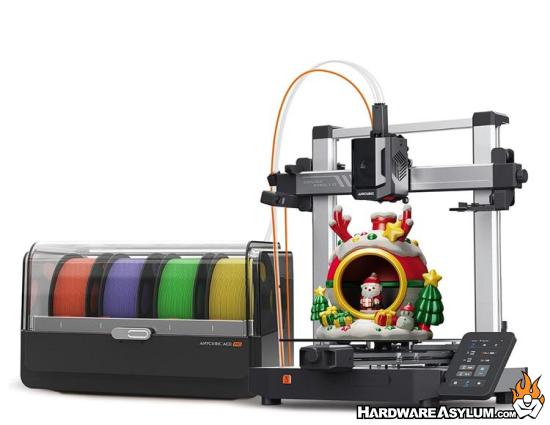
Brief introduction: A speed-forward budget printer that still produces clean surfaces when profiles are dialed. The high-flow hotend, stronger part cooling, and fast motion make quick work of PLA, with app checks for convenience.
Key specs:- Speed class: Up to 600 mm/s advertised with high acceleration
- Leveling: Assisted routine with mesh compensation
- Extruder: High-flow direct drive
- Plate: Textured flexible sheet
Why this pick: Choose Kobra 3 V2 Combo if you want short print times and you are willing to adopt proven profiles. It is a solid platform for fast iteration on brackets, organizers, and cosplay accessories.
4. ELEGOO Neptune 4 Plus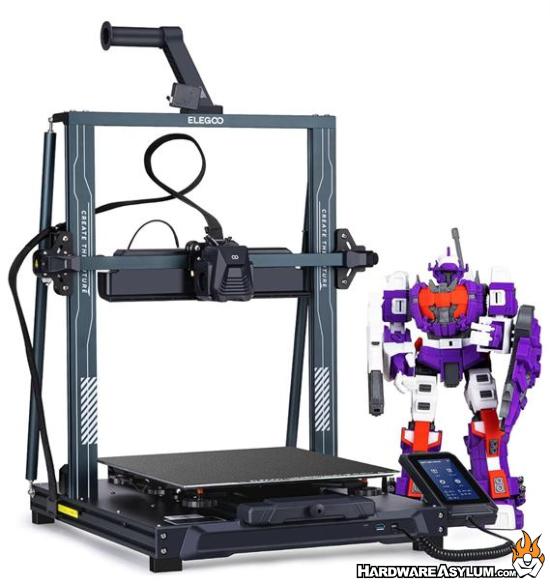
Brief introduction: Klipper firmware out of the box with input shaping brings high-end motion control to a budget price. Dual-gear direct drive and aggressive cooling help with first-layer consistency and sharper overhangs.
Key specs:- Firmware: Klipper with input shaping and higher default accelerations
- Speed class: Up to 500 mm/s advertised
- Leveling: Dense mesh probing with assisted tramming
- Plate: PEI-coated spring steel
Why this pick: If you want modern motion control and a larger platform that will not feel cramped in six months, Neptune 4 Plus offers a strong blend of speed headroom and ease of use.
Quick buying tips
- First layer matters most. Run the first layer slow, clean the bed with isopropyl alcohol, and add a skirt or brim for larger parts.
- Start with PLA. It is the most forgiving material. Move to PETG once you understand cooling and retraction. Use an enclosure if you step up to ABS or ASA.
- Speed reality. Headline speeds assume tuned profiles and strong cooling. Ramp up gradually as you learn the machine.
- Keep spares. Stock extra nozzles, a spare PTFE tube if applicable, and a replacement PEI sheet. A little rail grease or light oil goes a long way.
Final thoughtsChoose your 3D printer the same way this guide was built: by prioritizing the features that prevent failed prints. If you want the quietest, tidiest setup with the least fiddling and the easiest path to a successful first layer, Flashforge Adventurer 5M Pro is the turnkey pick. If you value community tutorials, abundant profiles, and easy spare parts so you can learn fast and fix anything, Creality Ender-3 V3 SE is the dependable all-rounder. If your priority is cutting print times while keeping surfaces clean, Anycubic Kobra 3 V2 Combo delivers speed headroom at a budget price. Finaly, if you need more room to grow for larger cosplay pieces or batch prints and want modern motion control, ELEGOO Neptune 4 Plus gives you a bigger platform without a complex setup.
To get results that match what we described up top, follow the same fundamentals across all four. Run the first layer slowly and slightly hotter, wipe the PEI with isopropyl alcohol, and re-run leveling whenever you change nozzles or move the printer. Start with PLA as it is very forgiving and then step into PETG for more durable pieces. Every material reacts differently so once you are comfortable with one, experiment with another. Increase speed gradually as your profiles improve, and keep a spare nozzle and fresh PEI sheet on hand. Do that, and any of these budget machines will deliver the reliability that make desktop 3D printing feel effortless rather than experimental.
-
Silicon Power’s XPOWER Storm DDR5 RGB Wins Taiwan Excellence Award 2026
Taipei, Taiwan – November 19th, 2025 – XPOWER, the high-performance gaming brand of global memory leader Silicon Power (SP), has been honored with the Taiwan Excellence Award 2026 for its Storm DDR5 RGB UDIMM. Recognized for its outstanding performance, innovative engineering, and compelling aesthetic design, the XPOWER Storm delivers the speed, stability, and visual flair that today's gamers and PC enthusiasts demand.

High-Performance DDR5 Meets Reliability
The XPOWER Storm stands out with its impressive performance, reaching speeds of up to 8000MT/s with low-latency configurations from CL28 to CL38. Its advanced architecture delivers exceptional responsiveness for high-demand gaming, multitasking, and content creation workloads—pushing the limits of what modern systems can achieve. Operating at a low voltage of 1.35V to 1.45V, the XPOWER Storm maintains outstanding efficiency while sustaining extreme performance. With built-in PMIC power management, On-Die ECC, and full support for Intel® XMP 3.0 and AMD EXPO, users can unlock maximum speed with effortless, stable overclocking.
Award-Winning Design Inspired by Nature
What sets the XPOWER Storm apart is not only its power, but its presence. Inspired by the dynamic silhouette of a shark in motion, the heat-spreader features a curved dorsal-fin profile and symmetrical gill-slit accents. These elements house integrated RGB lighting, which radiates through the fins and gills to create a vibrant, customizable visual effect compatible with all major motherboard lighting software.
Stable, Efficient, and Future-Ready
Built for sustained, high-intensity performance, the XPOWER Storm leverages DDR5 architecture to deliver faster data access, improved stability, and greater bandwidth for next-generation systems. The aluminum heat-spreader construction ensures efficient thermal management, keeping systems cool and stable even under relentless workloads. Available in Single Modules (16GB, 32GB) and Dual-Channel Kits (32GB, 64GB), each unit is backed by SP’s Limited Lifetime Warranty, providing long-term confidence for users who demand both speed and durability.
As global demand for high-performance computing continues to rise, the XPOWER Storm stands as a testament to Silicon Power’s innovation-driven approach. It reinforces the company’s commitment to delivering next-generation memory solutions that elevate the gaming and DIY PC ecosystem and empower gamers, creators, and advanced users worldwide.
-
Noctua presents chromax.black versions of its NH-D15 G2 and NF-A14x25 G2
Vienna, November 19th 2025 – Noctua today presented all-black chromax line versions of its award-winning G2 flagship models: Both the NH-D15 G2 CPU cooler and the NF-A14x25 G2 140mm fans have successfully set new standards for performance-to-noise efficiency, and the new chromax.black versions provide the same, award-winning quiet cooling performance in a sleek, unobtrusive design.
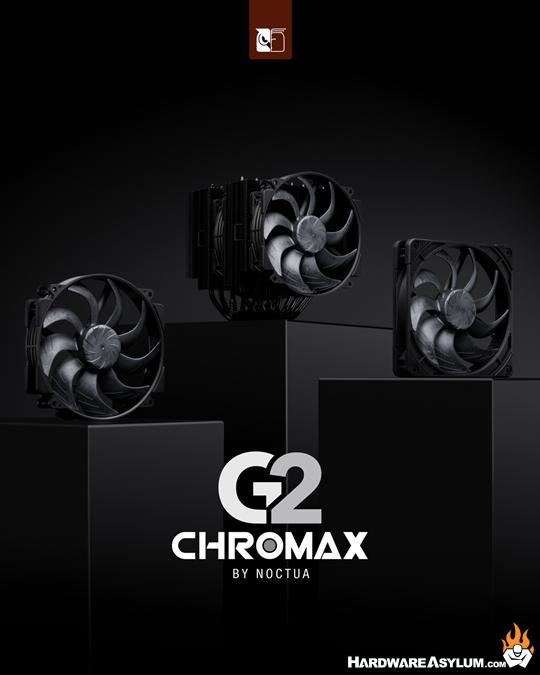
“The response to our long-awaited G2 series products has been amazing, both from customers and expert reviewers,” says Roland Mossig (Noctua CEO). “We’re proud that the NH-D15 G2 and NF-A14x25 G2 have managed to continue the legacy of their iconic predecessors, and we’re confident that the new chromax.black versions will be well received by those who prefer a stealthy, unobtrusive look.”Succeeding the iconic NF-A14 and NF-A15, the square-frame NF-A14x25 G2 and round-frame NF-A14x25r G2 have quickly established themselves as a new benchmark for premium quality quiet 140x25mm fans. Their advanced aerodynamic engineering featuring a novel Progressive Bend impeller design with a Centrifugal Turbulator hub, winglets, and a record tight tip clearance of only 0.7mm enables the G2 models to provide a significant boost in performance-to-noise efficiency over their renowned predecessors: Whether it’s in low-impedance, airflow-oriented applications such as case cooling, or high-impedance, pressure-demanding scenarios such as on heatsinks and water cooling radiators, where their etaPERF motor with SupraTorque allows leveraging extra torque headroom, the NF-A14x25 G2 fans are proven winners.
The chromax.black editions combine the NF-A14x25 G2s’ Sterrox liquid-crystal polymer impeller, comprehensive feature set and breakthrough quiet cooling proficiency with an attractive black design that can be customised with coloured anti-vibration pads, which are available separately.
Continuing the legacy of the iconic NH-D15, the NH-D15 G2 has received more than 100 awards and recommendations from international hardware websites and magazines since its introduction in summer 2024. Utilising the same further refined 8-heatpipe heatsink and state-of-the-art NF-A14x25r G2 PWM fans, the chromax.black version offers the same winning combination of cutting-edge cooling efficiency and superb quietness of operation. At the same time, its black fans and black coated heatsink enable it to merge these assets with a sleek stealth look. Topped off with the Torx based SecuFirm2+ multi-socket mounting system, Noctua’s highest performing NT-H2 thermal compound and a full 6-year manufacturer’s warranty, the NH-D15 G2 chromax.black is a deluxe choice for everyone who seeks an elite-class heatsink that looks just as great as it cools. -
BIOSTAR Introduces EdgeComp MS-NANO 4G/8G
HIGH-PERFORMANCE EDGE AI SYSTEM WITH JETSON ORIN NANO
November 18, 2025 – TAIPEI, TAIWAN – BIOSTAR, a leading manufacturer of edge computing solutions, industrial motherboards, graphics cards, and storage devices today, is excited to introduce the EdgeComp MS-NANO 4G/8G, a powerful fanless edge AI system powered by the NVIDIA® Jetson Orin™ NANO module with support for Super Mode. Designed for system integrators and AI developers, the EdgeComp MS-NANO delivers intelligent performance across deployment-ready applications, including smart retail, industrial automation, smart cities, logistics, and next-generation agriculture.
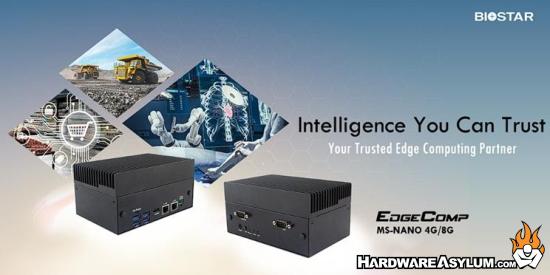
Built for practical edge AI deployment, the EdgeComp MS-NANO 4G/8G delivers robust performance across a wide range of industry applications. In smart retail, it enables automated checkout, inventory tracking, shopper analytics, and in-store traffic monitoring. For industrial and manufacturing environments, it supports intelligent inspection, robotic automation, remote operations, and predictive maintenance. Smart city deployments benefit from advanced features such as traffic flow management, number plate detection, and perimeter monitoring. In transportation and logistics, the system powers AMRs, smart sorting, and fleet management solutions. In modern agriculture, it provides reliable AI support for autonomous tractors, selective spraying, robotic pollination, and livestock health monitoring.
The EdgeComp MS-NANO 4G/8G is engineered with a compact, fanless design for reliable operation in harsh environments, supporting a wide temperature range from -20°C to 50°C. It features the NVIDIA® Jetson Orin™ NANO module with support for Super Mode, delivering up to 40 TOPS of AI performance for demanding edge workloads. Available in both 4GB and 8GB LPDDR5 configurations, the system scales to meet diverse application requirements, offering up to 68GB/s memory bandwidth. Equipped with a 1024-core NVIDIA Ampere architecture GPU with 32 Tensor Cores and a 6-core Arm Cortex-A78AE CPU, it delivers exceptional processing power for real-time AI inference. The system supports Linux JetPack 6.2 and is compatible with modern AI frameworks, including LLMs, SLMs, VLMs, and DeepSeek R1. Designed for deployment flexibility, it includes rich I/O options such as USB 3.2 ports, both GbE and 2.5GbE LAN, RS232/422/485, CAN bus, and audio interfaces. Optional features such as dual PoE ports and dual GMSL support provide extended connectivity for camera, sensor, and power integration in edge environments.
For storage and expansion, the EdgeComp MS-NANO 4G/8G includes one M.2 Key-M slot supporting 2242/2260/2280 NVMe SSDs, alongside an M.2 Key-B slot for 4G/5G modules, an M.2 Key-E slot for Wi-Fi and Bluetooth connectivity, and a Nano SIM slot for mobile communication. Network options include one GbE LAN and one 2.5 GbE LAN port, both with optional PoE functionality. The system also features four USB 3.2 Type-A ports, one Micro USB port for OS flashing, and one HDMI® 1.4 output for display or debugging use. Multiple serial connections, including RS232, RS232/422/485, and CAN, enable integration with a wide range of industrial devices. Additional features include a 3.5mm audio jack for Line-Out and Mic-In, as well as dedicated power, reset, and recovery buttons for streamlined system control. With a wide 12V to 20V DC power input range and compact 160 x 102 x 80 mm dimensions, the EdgeComp MS-NANO is built for stable 24/7 operation in space-constrained and mission-critical environments.
With its powerful AI capabilities, modular connectivity, and rugged design, the EdgeComp MS-NANO 4G/8G is the ideal solution for system integrators and software developers building advanced edge AI applications. Whether deployed in urban infrastructure, industrial automation, or remote agricultural systems, it delivers the performance and reliability needed to meet the demands of intelligent computing at the edge. -
ASRock X870 Live Mixer Wi-Fi Motherboard Review @ TechPowerUp
TechPowerUp review of the ASRock X870 Live Mixer Wi-Fi. TechPowerUp, known for their rigorous testing methodologies and detailed analysis, delivered a largely positive assessment of this AMD X870 motherboard. The reviewer was impressed by the board's feature set, particularly its focus on content creation and live streaming, with integrated features like a dedicated HDMI output for direct streaming and a robust audio solution. They highlighted the inclusion of PCIe 5.0 support for both graphics cards and NVMe SSDs, as well as a generous array of USB ports. The reviewer also praised the board's solid power delivery system, capable of handling the latest Ryzen 7000 series processors.
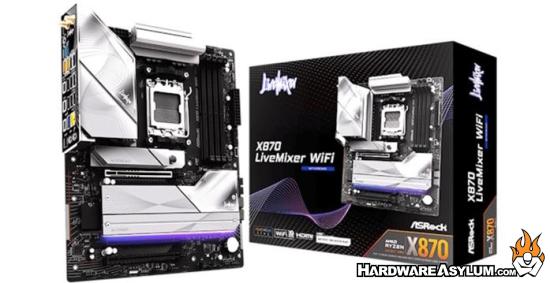
ASRock nails the price to performance ratio yet again with great VRM and SSD cooling and a slightly mad number of USB ports. However, the age-old questions remain such as is B850 a better choice or should you stump up the cash for X870E instead?
Beyond the core specifications, TechPowerUp commended the board's user-friendly BIOS, which offered a good balance of customization options and ease of navigation. They also appreciated the board's aesthetic appeal, with its dark color scheme and subtle RGB lighting. While the reviewer did mention a few minor concerns, such as the placement of a couple of audio connectors, they ultimately concluded that the ASRock X870 Live Mixer Wi-Fi represents a compelling option for content creators and gamers seeking a feature-rich and reliable motherboard. For those prioritizing live streaming capabilities and a solid foundation for their system, this board is definitely worth a look. -
LIAN LI Launches SP Platinum SFX Series PSUs with 80 PLUS® Platinum Certification
November 14th, 2025, Taipei, Taiwan – LIAN LI, a leading manufacturer of computer chassis and accessories, announces the SP Platinum Series, fully modular 850W and 1000W SFX power supplies engineered for high-end small-form-factor builds. Delivering 80 PLUS® Platinum certified efficiency, the SP Platinum meets Intel ATX 3.1 and PCIe 5.1 requirements and integrates LIAN LI’s in-house designed 12V-2x6 for reliable modern GPU power delivery. It features a 92mm FDB fan with a smart curve that is powered off at ≤40% load for silent operation. For tighter cable management and easier routing, it includes super-flexible braided modular DC cables, along with an extension power cord featuring an inline on/off switch, which enables external power control. Built with 100% Japanese 105°C capacitors and a full protection suite, each unit ships with an SFX-to-ATX bracket for broader chassis compatibility.
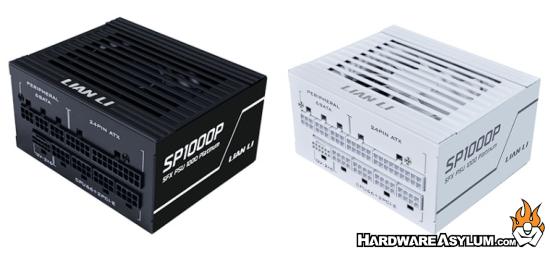
Platinum Power, Next-Gen Standards
The SP Platinum Series is 80 PLUS® Platinum certified, delivering up to 92% efficiency at 50% load, while maintaining precise regulation and low ripple under changing workloads. The PSU series fully complies with Intel ATX 3.1 and PCIe 5.1 standards and comes with an in-house engineered 12V-2x6 GPU cable, built with alloy copper terminals for lower contact resistance, higher thermal tolerance, and a dual-color connector to facilitate a clear insertion check. For longevity and clean output, the SP Platinum utilizes 100% Japanese 105°C capacitors, and it’s protected by a comprehensive suite of protections, including OCP, OVP, OTP, OPP, SCP, UVP, NLP, and SIP, which cover overcurrent, over/under-voltage, over-temperature, short-circuit, and more.Service-Friendly Power Control and Quiet Operation
For builds where the PSU is mounted internally and rear AC access is limited, each unit includes an IEC 320 C14-to-C13 extension cord with an inline on/off switch, allowing users to turn off their PSU without needing to open their case. The SP Platinum is also equipped with a 92mm FDB fan, which features a smart thermal curve that enables the fan to completely stop at loads of 40% or less, effectively eliminating idle noise.Clean Routing for SFF, Drop-In ATX Compatibility
The SP Platinum comes with super-flexible, braided-texture modular DC cables, making cable management in tight, small-form-factor cases easier. These cables bend easily around components, reducing clutter for better airflow. An SFX-to-ATX bracket is included, allowing the SP Platinum to mount seamlessly in standard ATX enclosures.Availability
The LIAN LI SP Platinum Series PSUs are available in black or white starting November 14th, 2025. -
Ryzen 5 7500X3D Review @ Guru 3D
AMD’s Ryzen 5 7500X3D brings the company’s 3D V-Cache technology to a far more accessible price point, offering 96 MB of L3 cache on a 6-core Zen 4 processor. Despite its modest core count and a relatively conservative boost frequency, the chip delivers excellent gaming performance thanks to the stacked cache architecture, achieving near-flagship results at 1080p and 1440p while maintaining a highly efficient 65 W TDP. For budget-minded gamers or AM5 adopters looking for maximum performance per dollar, the 7500X3D positions itself as a standout value in the current CPU landscape.
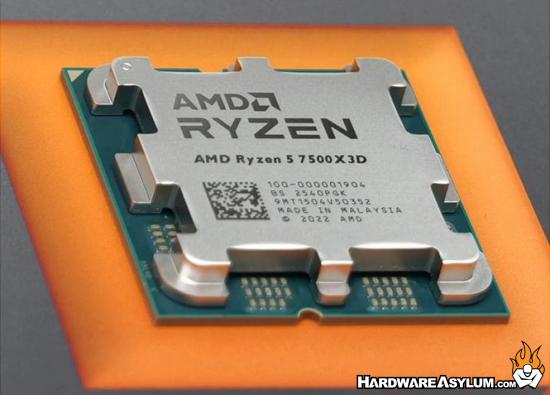
The Ryzen 5 7500X3D has been quietly building buzz ever since listings first appeared online a few weeks ago. This new CPU will feature 6 cores and 12 threads based on AMD’s Zen 4 architecture for the AM5 platform. It inherits the same 3D V-Cache technology that made its predecessors so popular, reportedly stacking up to 102 MB of total cache — with 96 MB of L3 and 6 MB of L2. Boost clocks are to reach just around 4.5 GHz, while keeping power consumption impressively low with a 65 W TDP. This combination makes it potentially the most efficient X3D chip AMD has ever released. With a price tag of around €279, the Ryzen 5 7500X3D could become the first truly budget-friendly 3D V-Cache processor — bringing near-flagship gaming performance to mainstream builders. It’s shaping up to be an ideal drop-in upgrade for anyone already running an AM5 motherboard and looking for top-tier gaming performance without breaking the bank.
However, its strengths in gaming do not extend equally to heavy productivity tasks, where higher-core-count CPUs predictably pull ahead. The review notes that platform cost DDR5 memory plus AM5 motherboards, still influences overall value, but the processor itself provides exceptional efficiency, strong frame-time consistency, and impressive gaming throughput for its class. For users focused primarily on gaming with occasional multitasking, the Ryzen 5 7500X3D earns its title as a “budget gaming champion,” delivering top-tier performance at a mainstream price point.

